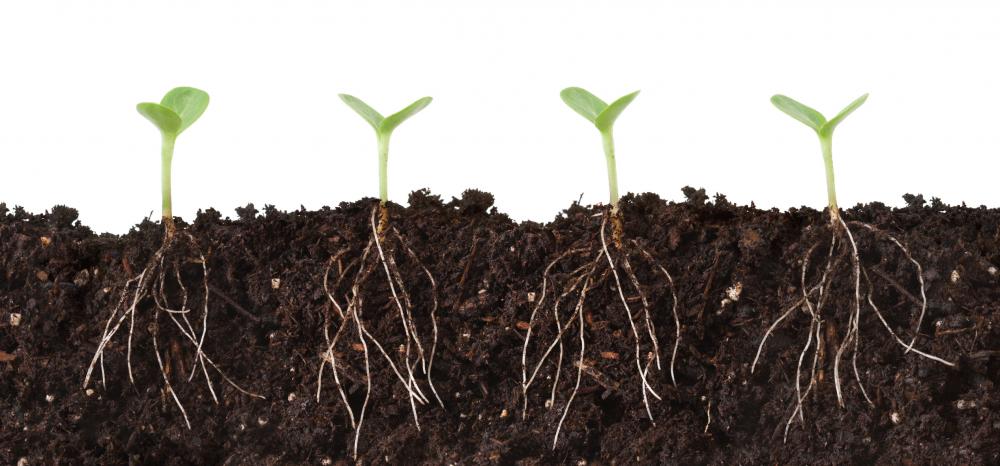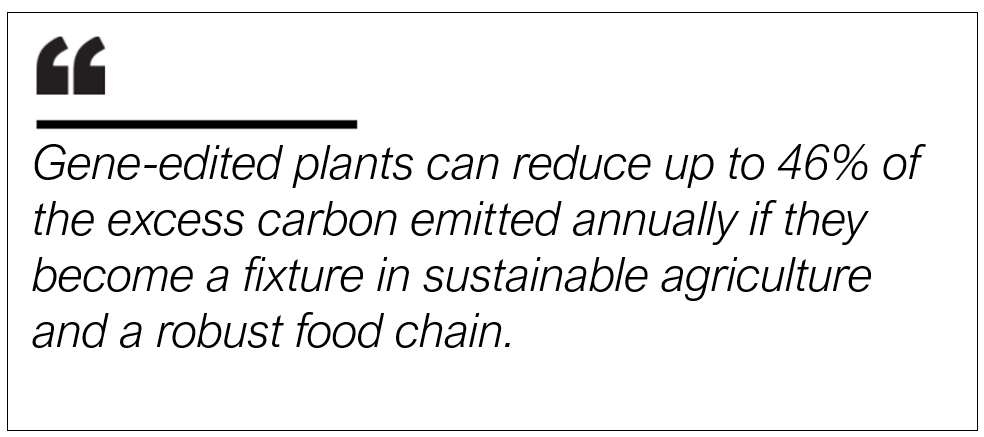5 min Read
To protect the earth’s ecosystem and natural resources for future generations, everyone must work together now. Gene editing is an advancement in plant and animal breeding that can support sustainability by helping farmers conserve water, reduce pesticide use, enhance soil health, improve air quality, safeguard animal well-being, and protect wildlife. Gene editing breakthroughs are helping to feed the world, protect the planet, and combat climate change.
Gene Editing Makes Plant Breeding More Precise
In the gene-editing process, scientists use a molecular tool like CRISPR to make targeted improvements to a plant’s DNA, typically working solely within the plant’s own family. Gene editing’s precision in targeting almost any desired location in the genome is one of its biggest advantages over other plant breeding methods.
In many cases, the same changes made through gene editing could occur naturally, through evolution or traditional breeding methods. But the precision and efficiency of gene editing enables plant breeders to achieve the same result in years instead of decades.
How Can Gene Editing Help Sustain the Planet’s Ecosystems?
The world’s population and food needs will continue to grow in the coming decades, which could increase sustainability challenges. We need to find better ways to increase the global food supply while also protecting our natural resources and the long-term health of our ecosystems. Gene editing can make a major difference by:
• Reducing the amount and type of inputs needed to increase crop production.
• Minimizing food waste that contributes to sustainability challenges.
• Mitigating the impact of climate change on farming and ranching.
• Addressing the factors that cause climate change to help lessen or prevent its impacts on the planet.
4 Ways Gene Editing Could Make Farming Practices More Sustainable
With its ability to provide precise and targeted improvements to plants’ characteristics, gene editing can reduce the amount of water, pesticides, fertilizers, land, and other resources and inputs needed to grow crops. Gene editing can help minimize farmers’ use of these resources and inputs in many ways, including by:
1. Enabling plants to use water more efficiently. Gene editing provides the opportunity to develop crops that require less water to grow. In 2018, scientists discovered that by altering the expression of a gene in tobacco plants that is also present in all plants, they could make the tobacco plants 25% more water efficient. Now they are testing this characteristic on food crops. Researchers also are exploring other ways to use gene editing to make corn and other food crops tolerant of the droughts that climate change has made more common.
2. Strengthening plants’ internal defenses. By making crops naturally resistant to diseases and pests, gene editing can make crops hardier and more resilient. That’s particularly important as average temperatures increase, because insect populations and their appetites surge in warm climates. Advances already are being made on this front with popular coffee plant varieties, cacao trees, sweet potatoes, bananas, and more.
3. Boosting plants’ natural access to nitrogen and other nutrients. Gene editing can enable corn crops to naturally access nitrogen in the air; in 2019, an Indiana farmer became this corn crop’s first customer. Gene editing technology is also boosting the natural ability of microbes in soil to produce nitrogen and enhance nitrogen absorption.
4. Limiting the need to expand farming to undeveloped land. By making plants more resilient, gene editing enables more of them to survive and thrive and makes the farmland already in use more productive. By helping crops like rice thrive in marginal soil, gene editing helps farmers make the most of existing agricultural land.
How Gene Editing’s Impact on Food Freshness Benefits the Planet
One-third of all food produced for human consumption is either prematurely discarded by consumers or lost to inefficiencies in the food supply chain, according to a report by the United Nations Food and Agriculture Organization. That amount of food waste and loss takes a toll on sustainability because it means farmers have to use more resources and land to grow more crops.
Gene editing can reduce food waste by helping food stay fresh longer, including by making many fruits and vegetables more resistant to browning or bruising. For example, gene editing can cut the volume of potato waste in half. This advancement also helps alleviate climate change: The United Nations estimates that food waste is tied to 8% of greenhouse gas emissions.
[infographic title="Food Waste is Land Waste" sidebar="false" description="Less food loss and waste would lead to more efficient land use and better water resource management, according to the United Nations Food and Agriculture Organization."][/infographic]
3 Ways Gene Editing Can Address the Factors That Cause Climate Change
Gene editing can help reduce greenhouse gas emissions and remove excess carbon from the atmosphere, making it an essential tool in efforts to address climate change. That’s critical for environmental sustainability: As more than 11,000 scientists from 153 countries warned in November 2019, climate change’s impacts could threaten natural ecosystems and make large areas of the Earth uninhabitable.
Specific ways that gene editing can contribute to climate change solutions include:
1. Capturing carbon in crop roots. Gene editing can enable crop plants to grow bigger and deeper roots that are incredibly effective in capturing carbon and storing it in the soil for extended periods of time.
2. Replenishing carbon-absorbing trees. Scientists discovered a way to restore native forests of the fast-growing American chestnut tree, which absorbs and stores large amounts of carbon to fuel its growth.
3. Providing sources of low-carbon biofuel. Gene editing can create varieties of a plant called pennycress that are high in oleic acid — well-suited for conversion into diesel or jet fuel. Many farmers already use pennycress in their off-season to help prevent soil erosion and keep nutrients in the soil.
Learn more about the ways that gene editing can help provide a climate change solution.
The Future of Gene Editing Innovations for Sustaining the Environment and Food Supply
As gene editing knowledge grows and the number of applications increase, it will continue to provide more and easier ways to grow crops, preserve resources, and enhance animal well-being. In the articles below, we highlight some of the latest advancements that will help drive this increase in sustainability.
Learn More About Gene Editing’s Potential Benefits for a Sustainable Food System:
Meal Prep With A Side Of Sustainability
Dr. Kasia Glowacka: Plants That May Thrive With Less Water
An Ancient Variety of Corn Could Help Combat Climate Change. Here’s How
Gene Editing Has The Potential To Create A Healthier Future For Farm Animals
Three Scientists Weigh In On The Future Of Agriculture


